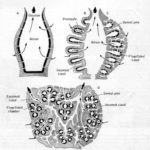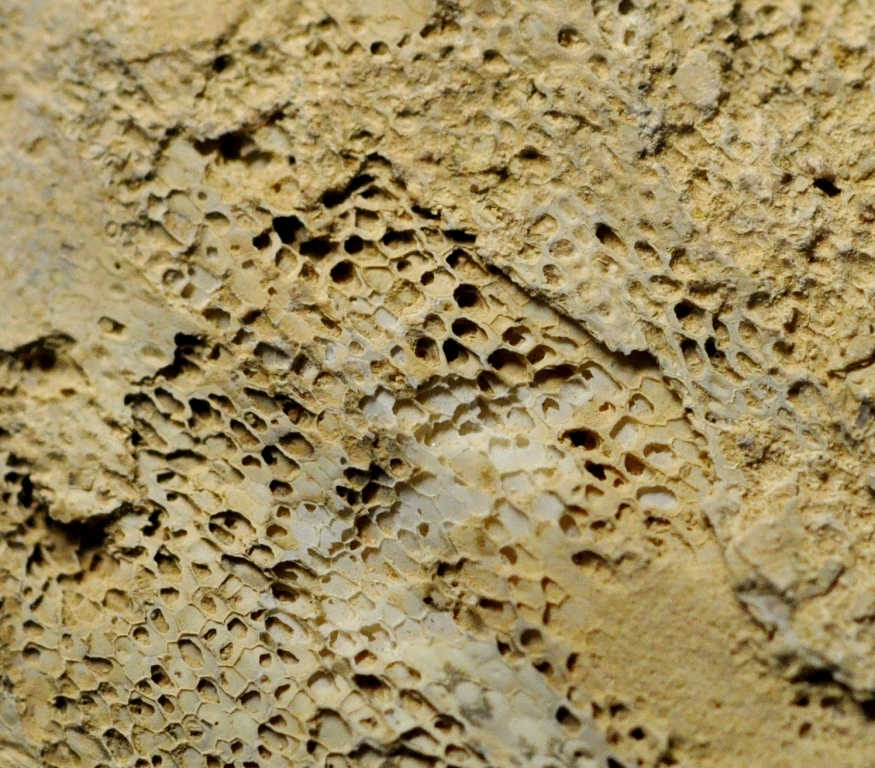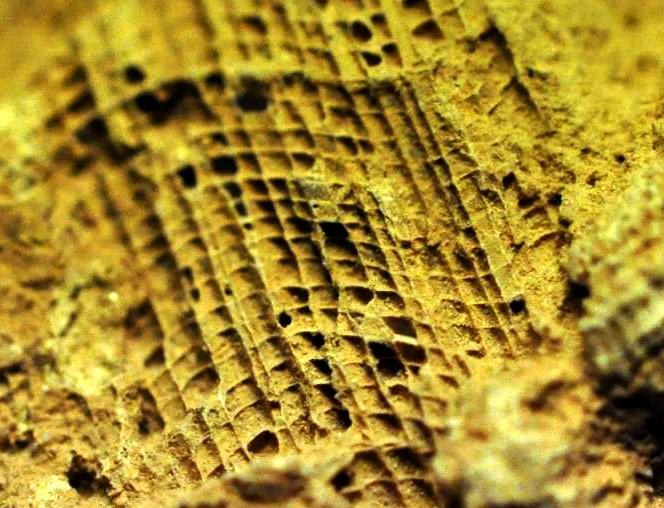Sponges have been in the news lately thanks to the discovery of “Volkswagen” sized specimen discovered off the coast of Hawaii recently. Yep, that’s a lot of sponge alright but probably not all that uncommon. We have a fair number of species gracing our Northwest waters. With many thousands of sponge species living worldwide it is hardly surprising to find great so many in our own waters. Don’t try finding them in freshwater, however. Only a very small number have manged to master that environment. What is surprising is just how widespread and successful this very “simple” organism has become. They hardly move at all, have no mouth, and rely on flagella to transport food through tiny holes in their body. Yet there is one species of sponge that is actually carnivorous. Sponges are the oldest known fossils animals according to many resources.
One of the greatest places to find sponge fossils is – believe or not – Saudi Arabia, where I photographed these specimens. On the far left is a close up of the exterior of the animal clearly showing the tine holes through which food waters and waste is transported. Note, however, the more rectangular shape seen on the inside of the fossil.
Three classes of Sponges represent the Phylum Porifera in the Northwest. Below is a list of the more common:
Class Calcera – the Calcerous Sponges
Vase Sponge Scypha compacta
Stalked Sponge Leucilla nuttingi
Bristly Vase Sponge Leucandra heathi
Tube Ball Sponge Leucopoenia eleanor
Tube Sponge Leucopoenia nautilia
Class Hexactinellida – the Glass Sponges
Goblet Sponge Conelasma calyx
Cloud Sponge Aphrocallistes vastus
Chimney Sponge (2 species) Rhabdoclyptus dawsoni and Straurocalyptus dowlingi
Class Demospongiae – Most common North American Sponges
Yellow Boring Sponge Cliona celata
Rough Scallop Sponge Myxilla incrustans
Smooth Scallop Sponge Mycale adhaerens
Hermit Crab Sponge Suberities fiscus
Purple Encrusting Sponge Halicolona permollis
Bread Crumb Sponge Halichondria spp
Velvety Red Sponge Ophlitaspongia pennata
Your ads will be inserted here by
Easy Plugin for AdSense.
Please go to the plugin admin page to
Paste your ad code OR
Suppress this ad slot.
Yellow Encrusting Sponge Myxilla lacusnosa
Red Volcano Sponge Acarnus erithacus
Orange Ball Sponge Tethya californiana
Tennis Ball Sponge Craneilla villosa
Spiny Tennis Ball Sponge Craniella spinosa
Glove Sponge Neoesperiopsis digitata
Orange Finger Sponge Neoesperiopsis rigida
Trumpet Sponge Stylissa stipitata
Aggregated Vase Sponge Polymastica pacifica
Salt and Pepper Sponge Penares cortius
Peach Ball Sponge Suberites montiniger
Iophon sponge Iophon chelifer
White Sponge Adioca sp.
Chocolate Puffball Sponge Latrunuclia sp.
For pictures of all of the above species I suggest “Whelks to Whales, Coastal Marine Life of Oregon, Washington, British Columbia and Alaska” by Rick M. Harbo, Harbour Publishing, 1999, the reference I used to compile this list. For online reference I recommend:
http://www.ucmp.berkeley.edu/porifera/porifera.html
Sponges are a classic example of how the most simple of living organisms are surprisingly complex. These most primitive of multicellular animals have neither true tissues or organs. They are the “missing link” between single celled and multi celled organisms. They are so simple in structure, in fact, that ancient scientists like Aristotle and Pliny considered them plants. It was not until 1765 that sponges were finally deemed to belong to the animal kingdom.
Of the 5,000 to 10,000 species of sponges on earth all inhabit water. Of these thousands, however, all but a relative handful are marine dwellers. There are currently only about 150 species of freshwater sponges. Sponges are found in all the oceans of the world from boat docks to depths of 28,000 feet. They can be anywhere from the size of a marble to the size of a cow. Many display radial symmetry, but a large number have irregular shapes, tall column shapes, and a myriad of other forms. Some are flat and some spread like lichens. They encompass all the colors of the rainbow.
So what then exactly is a sponge? The sponges are perhaps best described as a group of single cells that all manage to work together. To understand a sponge by examining a single one of its cells, even though most are practically identical, would do you no more good than studying the single cell of any other multicellular creature. The organism must be studied as a whole. Yet experiments have shown that if a sponge is strained through a silk mesh the separated individual cells will regenerate and form themselves into several new sponges. That even beats the legendary powers of sea stars for regeneration.


These drawings from my old college textbook, “Invertebrate Zoology,” by Dr. Robert D. Barnes offer a great representation of the inner workings of the different types of sponges. The diagram on the left shows the common feature of all sponges – filter feeding by use of self generated water currents. (Hence the name Porifera, “Hole Bearers.”) Water flows through two layers of cells that are separated by a jelly like substance. Larger sponges form more complex canals. The water, together with tiny food particles flows into the atrium, and then out of the top of the sponge called the osculum. The diagram on the right is a magnified view of the inner, flagellated cells of a sponge. These flagella beat incessantly pulling water into the sponge and pushing it out of the organism.





Leave a Reply
You must be logged in to post a comment.